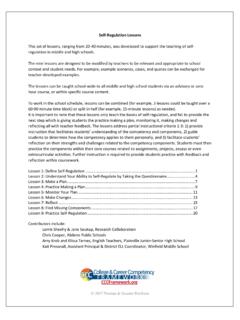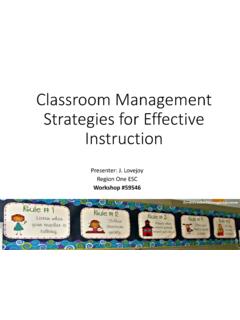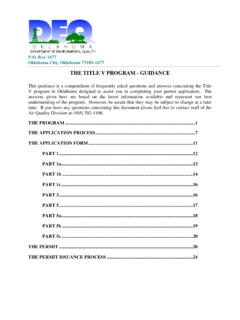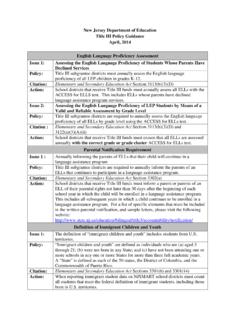Transcription of GUIDANCE ON BILINGUAL EDUCATION ALLOTMENT (BEA) …
1 GUIDANCE ON BILINGUAL EDUCATION ALLOTMENT (BEA) and title iii , PART A FUNDS Page 1 PURPOSE BILINGUAL EDUCATION ALLOTMENT (BEA) 164 title III, PART A FUNDS 263 A. ALLOWABLE PROGRAM EXPENDITURES Program and Student Evaluation It is allowable to use the BILINGUAL EDUCATION ALLOTMENT (BEA) to purchase materials for BILINGUAL and special language programs or for English language learners *(ELLs) student evaluation as long as these are not assessments required to be administered to all students as part of other **district/school evaluations. Allowable purchases are: assessment instruments for identification, placement, and exiting of students, assessments from the List of Approved Tests for Assessment of Limited English Proficient Students* (LEP); TEJAS LEE, other state supported English language proficiency tests, Texas English Language Proficiency Assessment System (TELPAS). *The acronyms LEP and ELL are used interchangeably **The acronym for local EDUCATION agency (LEA) is used interchangeably with district title III does require that LEAs receiving funds provide services that increase the English proficiency of limited English proficient children by providing high-quality BILINGUAL /ESL programs that are based on scientifically based research.
2 The goal is to increase English proficiency and student academic achievement in the core academic subjects. title III also allows LEAs to use funds to upgrade program objectives and implement effective instructional strategies. Regarding program evaluation, each LEA receiving funds under title III, Part A is required to submit an evaluation to the Texas EDUCATION Agency every fiscal year. The evaluation is used by the LEA for the improvement of programs and activities and to determine the effectiveness of approaches used. An annual compliance report form for title III, Part A is available to LEAs on eGrants at the end of each school year. Instructional Materials and Equipment It is allowable to use the BILINGUAL EDUCATION ALLOTMENT (BEA) to purchase materials that ensure linguistic and academic differentiation/support of English language learners. Allowable purchases include: visual aids (cameras, videos, pictures, posters, computers, CDs, DVDs) and LEAs can use title III funds to improve the instructional program for limited English proficient children by identifying, acquiring, and upgrading curricula, instructional materials, educational software, and assessment procedures.
3 Any GUIDANCE ON BILINGUAL EDUCATION ALLOTMENT (BEA) and title iii , PART A FUNDS Page 2 PURPOSE BILINGUAL EDUCATION ALLOTMENT (BEA) 164 title III, PART A FUNDS 263 manipulatives (math, reading, science, etc) that are directly related to the enhancement of instruction to ELLs. These instructional materials and equipment that serve the needs of ELLs are above and beyond the materials and equipment provided to all the other teachers in the general EDUCATION program. instructional materials and equipment purchased with these funds must be supplemental to the regular instructional program and cannot be purchased to meet state or other federal requirements. Staff Development It is allowable to use the BILINGUAL EDUCATION ALLOTMENT (BEA) to build educators capacity to differentiate instruction, curriculum, and assessment for linguistically, academically, and culturally diverse students. It is allowable to pay for ELL diversity training such as English Language Proficiency Standards (ELPS), Sheltered English Instruction, Gifted and Talented ELLs, Texas English Language Proficiency Assessment System (TELPAS), and Language Proficiency Assessment Committee (LPAC).
4 Whether this is an allowable use of title III funds depends on the following: Purpose for Attending If the training is required (for example, by the district for those with certain teaching placements, etc.), then this is NOT allowable; Funding of Training If funded through a source (such as a State grant, etc.) that could provide for this, then it is NOT allowable; and All Other Supporting Conditions If it is not to meet a requirement and no other funding source is available for it, this is allowable as long as all other supporting conditions are met (reflected in application, necessary and reasonable, the teachers are serving LEP students, etc.). Examples A. It may be allowable to use title III funds for a teacher to attend Sheltered Instruction training, provided that it is not required by local policy (for certain teaching assignments, etc.) and all other supporting conditions are met ( , reflected in the application, GUIDANCE ON BILINGUAL EDUCATION ALLOTMENT (BEA) and title iii , PART A FUNDS Page 3 PURPOSE BILINGUAL EDUCATION ALLOTMENT (BEA) 164 title III, PART A FUNDS 263 necessary and reasonable, the teachers are serving LEP students, etc.)
5 It is NOT allowable to use title III funds to send a teacher to training on the Texas English Language Proficiency Assessment System (TELPAS), as state policy requires administration of the TELPAS and training is required in order to administer it. It is allowable to use the BILINGUAL EDUCATION ALLOTMENT (BEA) to pay for educators to attend conferences, district, and regional EDUCATION Service Centers (ESC) BILINGUAL and ESL trainings to serve needs of ELLs if these trainings are above and beyond the trainings received by all the other teachers in the general EDUCATION program. Trainings must be targeted to meet the affective, linguistic, and cognitive needs of ELLs. BILINGUAL or ESL certification training and certificate At the District s discretion, is allowable to use the BILINGUAL EDUCATION ALLOTMENT (BEA) to provide the training for teachers desiring to obtain a BILINGUAL or ESL certification and/or to provide a stipend for certification. This may be an allowable use of title III funds if the school district is meeting all state requirements regarding BILINGUAL /ESL certification of its teachers.
6 It is only allowable to use title III funds for certification efforts that are above and beyond what is required under state policy. Examples A) It is allowable to use title III funds to pay for ESL certification training, testing, or stipends to attend the training if the purpose is to build capacity in order to be able to provide content- GUIDANCE ON BILINGUAL EDUCATION ALLOTMENT (BEA) and title iii , PART A FUNDS Page 4 PURPOSE BILINGUAL EDUCATION ALLOTMENT (BEA) 164 title III, PART A FUNDS 263 based ESL, rather than ESL pull-out instruction. This only allowable provided that the LEA is meeting state requirements to provide ESL but wishes to improve the ESL program by paying for more teachers to be ESL-certified. It is NOT allowable for a school district that is under a BILINGUAL exception or ESL waiver to use title III funds to help meet the state requirement that it uses 10% of its BEA for certification training. This is NOT allowable if the certification meets a state requirement for teachers assigned to teach English language learners.
7 Supplemental Staff Expenses It is allowable to use the BILINGUAL EDUCATION ALLOTMENT (BEA) to provide extended-day tutorials for ELLs; academic enhancement; and linguistic acceleration of English proficiency acquisition. It is allowable to use the BILINGUAL EDUCATION ALLOTMENT (BEA) to hire BILINGUAL teacher assistants to supplement quality instruction provided by BILINGUAL and/or ESL certified teachers. It is also allowable to pay for a BILINGUAL /ESL program coordinator/facilitator, however; this person should be funded out of BEA indirect costs. Use of the term, extra-duty pay, typically refers to payment to staff already paid through the same program in question. As long as the activity is title III-specific and supplemental (and meets all other supporting conditions, such as necessary and reasonable, etc.), it is allowable. Salary Supplements for Teachers It is allowable to use the BILINGUAL EDUCATION ALLOTMENT (BEA) to provide a stipend to secure highly qualified BILINGUAL and ESL teachers for ELLs.
8 It is not allowable to use title III funds to pay bonuses or stipends based on teachers having BILINGUAL /ESL certification, as securing the certified teacher meets a state requirement for teachers GUIDANCE ON BILINGUAL EDUCATION ALLOTMENT (BEA) and title iii , PART A FUNDS Page 5 PURPOSE BILINGUAL EDUCATION ALLOTMENT (BEA) 164 title III, PART A FUNDS 263 assigned to teach English language learners. Other supplies required for quality instruction and smaller class size It is allowable to use the BILINGUAL EDUCATION ALLOTMENT (BEA) for printing costs for additional BILINGUAL /ESL materials required for quality instruction and smaller class size. As long as the other supplies are supplemental to all other funds and are not used to meet any other state or federal requirements, title III funds can be used for this purpose in order to improve the English proficiency and academic achievement of limited English proficient children. This can include the acquisition or development of educational technology or instructional materials; access to, and participation in, electronic networks for materials, training, and communication; and incorporation of the resources into curricula and programs.
9 PURPOSE BILINGUAL EDUCATION ALLOTMENT (BEA) NCLB, title III, PART A FUNDS B. ALLOWABLE ADMINISTRATIVE COSTS (DIRECT AND INDIRECT COSTS) INDIRECT COSTS The State Board of EDUCATION (SBOE) allows districts to use their state ALLOTMENT for indirect costs (19 TAC ) Indirect costs are expenditures classified under the following function codes: 34 Student Transportation 41 General Administration 81 Facilities Acquisition and Construction 90 Intergovernmental Charges 91 Contracted Instructional Services Between Public Schools 92 Incremental Costs Associated with Chapter 41, Texas EDUCATION Code, Purchase or Sale of Weighted Average It is allowable to use title III funds to pay for administrative costs to implement the title III program. However the amount of title III funds which may be used to pay administrative costs to implement the program must not exceed 2% of the program s budget amount. In calculating total administrative costs subject to the 2% limit, all appropriate indirect and direct costs, such as administrative salaries, must be included.
10 If the LEA contracts with an outside vendor to provide title III services, the LEA must require that the contractor break out administrative costs, which are GUIDANCE ON BILINGUAL EDUCATION ALLOTMENT (BEA) and title iii , PART A FUNDS Page 6 PURPOSE BILINGUAL EDUCATION ALLOTMENT (BEA) 164 title III, PART A FUNDS 263 Daily Attendance (WADA) 93 Payments to Fiscal Agent/Member Districts of Shared Services Arrangements 95 Payments to Juvenile Justice Alternative EDUCATION Programs 97 Payments to Tax Increment Fund 99 Other Intergovernmental Charges included within the 2% limit, as well. NOTE: Administrative costs include both direct administrative costs and indirect costs. Indirect administrative costs include costs associated with human resources, budgeting, accounting, purchasing, and other fiscal activities such as auditing. The salaries and benefits of staff that supervise program staff are part of the LEA s direct administrative costs.
















